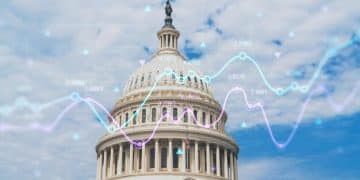New Healthcare Legislation: Will It Actually Cut Prescription Drug Prices by 2026?

New legislation aimed at lowering healthcare costs, particularly prescription drug prices, faces scrutiny regarding its potential impact by 2026, with debates centering on its effectiveness and long-term sustainability.
The soaring cost of healthcare is a major concern for Americans, and prescription drug prices are a significant part of that problem. Now, new legislation on healthcare costs: will it lower prescription drug prices by 2026? This is the question on everyone’s mind as Congress debates the latest proposals.
Understanding the Current Landscape of Healthcare Costs
Before diving into the specifics of the new legislation, it’s crucial to understand the current state of healthcare costs in the United States. For years, Americans have faced rising premiums, high deductibles, and exorbitant prescription drug prices. A recent study showed that the U.S. spends significantly more on healthcare per capita than other developed nations, yet often with poorer health outcomes.
Several factors contribute to these high costs, including:
- Lack of Price Negotiation: Unlike many other countries, the U.S. government doesn’t directly negotiate drug prices with pharmaceutical companies.
- Patent Protection: Pharmaceutical companies have exclusive rights to manufacture and sell drugs for a certain period, allowing them to charge high prices.
- Marketing and Advertising: Drug companies spend billions on marketing directly to consumers, which can drive up demand and prices.
- Complex Insurance System: The fragmented nature of the U.S. insurance system creates administrative inefficiencies and limits bargaining power.
Understanding these factors is essential for evaluating whether the new legislation can effectively address the root causes of high healthcare costs and deliver meaningful relief to consumers.

The Specifics of the Proposed Healthcare Legislation
The proposed legislation aims to tackle rising healthcare costs through several key provisions. These provisions target different aspects of the healthcare system, from drug pricing to insurance coverage.
Key Provisions of the Legislation
The new law includes several provisions designed to curb healthcare spending:
- Drug Price Negotiation: For the first time, Medicare will be allowed to negotiate prices for some of the most expensive prescription drugs.
- Inflation Caps: Drug companies will be required to pay rebates to Medicare if their drug prices increase faster than inflation.
These measures seek to directly address high drug prices, a major pain point for many Americans.
Expanding Access to Affordable Healthcare
Beyond drug prices, the legislation also aims to expand access to affordable healthcare coverage:
- Extending ACA Subsidies: Enhanced subsidies for health insurance purchased through the Affordable Care Act (ACA) marketplaces would be extended.
- Lowering Out-of-Pocket Costs: Measures to lower out-of-pocket costs for Medicare beneficiaries, such as capping insulin prices, are also included.
By making insurance more affordable and reducing out-of-pocket expenses, the legislation aims to improve healthcare access for millions.
These provisions, if implemented effectively, could lead to significant changes in the healthcare landscape. However, their success hinges on various factors, including the willingness of pharmaceutical companies to negotiate and the ability of the government to enforce the new regulations.
Potential Impact on Prescription Drug Prices by 2026
The central question surrounding this new legislation is whether it will actually lower prescription drug prices by 2026. The answer is complex and depends on several variables.
Direct Impact on Medicare Drug Prices
The provision allowing Medicare to negotiate drug prices is expected to have the most immediate and direct impact. By 2026, Medicare will have negotiated prices for a limited number of high-cost drugs, potentially leading to significant savings for beneficiaries. However, the scope of these negotiations is limited, and it will take time for the full impact to be realized.
Indirect Effects on Private Insurance
The legislation could also have indirect effects on drug prices in the private insurance market. If Medicare is able to negotiate lower prices, it could create pressure for private insurers to do the same. Additionally, the inflation caps on drug prices could help to moderate price increases across the board.
Challenges and Limitations
Despite the potential benefits, there are also challenges and limitations to consider. Pharmaceutical companies may try to offset the impact of price negotiations by raising prices on other drugs or delaying the introduction of new drugs. Additionally, legal challenges to the legislation could slow down or even derail its implementation.
The pharmaceutical industry’s response is likely to be complex, potentially involving strategies to mitigate the impact of the new law. It’s crucial to monitor these developments to fully understand the legislation’s effects.

Analyzing the Political and Economic Factors at Play
The fate of this new healthcare legislation, and its impact on prescription drug prices, is intertwined with political and economic factors. The political landscape in Washington, D.C., and the economic forces driving healthcare costs both play a significant role.
Political Gridlock and Bipartisan Support
Healthcare reform has long been a contentious issue in American politics. While there may be some bipartisan support for certain provisions of the new legislation, such as lowering drug prices, other aspects could face strong opposition. Political gridlock could make it difficult to pass additional reforms or to fully implement the current legislation.
The Role of Pharmaceutical Lobbying
The pharmaceutical industry is a powerful lobbying force in Washington, D.C. Drug companies spend millions of dollars each year to influence lawmakers and shape healthcare policy. Their lobbying efforts could weaken or undermine the new legislation, potentially limiting its effectiveness.
Examining the political dynamics surrounding the new legislation reveals a complex interplay of interests and ideologies. It’s essential to consider these factors when assessing the likelihood of the legislation meeting its goals.
- Economic pressures: Inflation and rising healthcare costs create urgency.
- Political will: Bipartisan support is crucial for long-term success of any reform.
The interplay between political and economic forces will continue to shape the healthcare landscape in the years to come. Understanding these dynamics is essential for navigating the complexities of healthcare reform.
The Long-Term Sustainability of Healthcare Cost Savings
Even if the new legislation succeeds in lowering prescription drug prices by 2026, the question remains whether these savings will be sustainable in the long term. Several factors could impact the long-term effectiveness of the legislation.
Innovation and Drug Development
Some argue that reducing drug prices could stifle innovation and lead to fewer new drugs being developed. Pharmaceutical companies rely on revenue from existing drugs to fund research and development of new treatments. If their profits are reduced, they may cut back on research, potentially slowing down the pace of medical innovation.
Market Dynamics and Competition
The dynamics of the pharmaceutical market could also impact the long-term sustainability of cost savings. If a few companies dominate the market, they may have the power to raise prices even if regulations are in place. Promoting competition among drug manufacturers could help to keep prices in check over the long term.
Consider how the regulation of biosimilars—essentially generic versions of biologic drugs—affects competition and pricing.
To ensure the long-term sustainability of healthcare cost savings, a multi-faceted approach is needed. This includes promoting innovation, fostering competition, and addressing the underlying factors that drive up healthcare costs.
Expert Opinions and Analysis on the Legislation
To gain a comprehensive understanding of the new healthcare legislation, it’s essential to consider the views of experts from various fields. Economists, healthcare policy analysts, and patient advocacy groups all have valuable perspectives on the potential impact of the legislation.
Economists’ Predictions
Economists offer different predictions about the economic impact of the legislation. Some economists believe that it will lead to lower healthcare costs and improved access to care, while others are more skeptical. They point out that the legislation could have unintended consequences, such as reduced investment in drug development.
Healthcare Policy Analysts’ Insights
Healthcare policy analysts focus on the practical implications of the legislation. They examine how it will be implemented, how it will affect different stakeholders, and what challenges it is likely to face. Their insights can help to identify potential pitfalls and maximize the effectiveness of the legislation.
Experts warn of potential unintended consequences. Policy analysts provide insights on implementation challenges.
Consulting a wide range of experts enhances the credibility of the analysis and provides readers with a balanced view of the legislation’s potential outcomes. It’s crucial to consider these diverse perspectives to form an informed opinion on the effectiveness of the new healthcare laws.
| Key Point | Brief Description |
|---|---|
| 💰 Medicare Negotiation | Medicare can negotiate prices for certain high-cost drugs. |
| 📈 Inflation Caps | Drug companies must pay rebates if prices increase faster than inflation. |
| ✅ ACA Subsidies | Enhanced subsidies for ACA health insurance are extended. |
| 💊 Out-of-Pocket Costs | Measures lower out-of-pocket costs for Medicare beneficiaries. |
Frequently Asked Questions
▼
The primary aim is to lower healthcare costs, particularly prescription drug prices, and improve access to affordable healthcare for Americans.
▼
The legislation grants Medicare the authority to directly negotiate prices for a select number of high-cost prescription drugs, aiming to reduce expenses.
▼
Challenges include pharmaceutical industry opposition, potentially stifled innovation, and market dynamics affecting price sustainability over time.
▼
Yes, indirectly. If Medicare negotiates lower prices, private insurers may face pressure to do the same, which could potentially lower costs.
▼
The first impacts are expected by 2026, with Medicare negotiating prices for a limited number of drugs, leading to initial savings for beneficiaries.
Conclusion
In conclusion, the new legislation on healthcare costs: will it lower prescription drug prices by 2026? While the legislation holds promise, its success will depend on various factors, including the pharmaceutical industry’s response, effective implementation, and sustained political will. It remains to be seen whether the proposed measures will deliver meaningful and lasting relief to Americans struggling with high healthcare costs.





